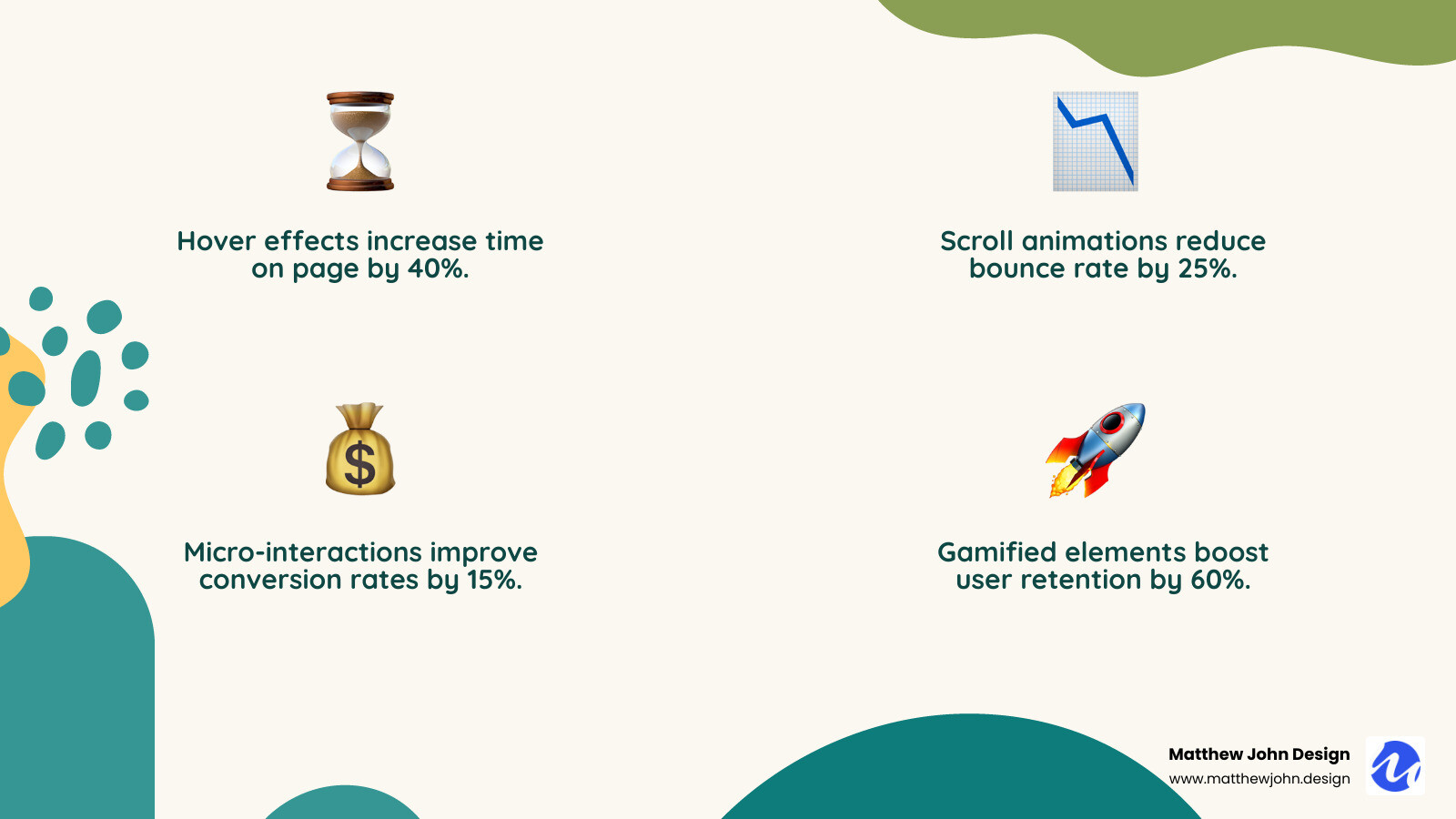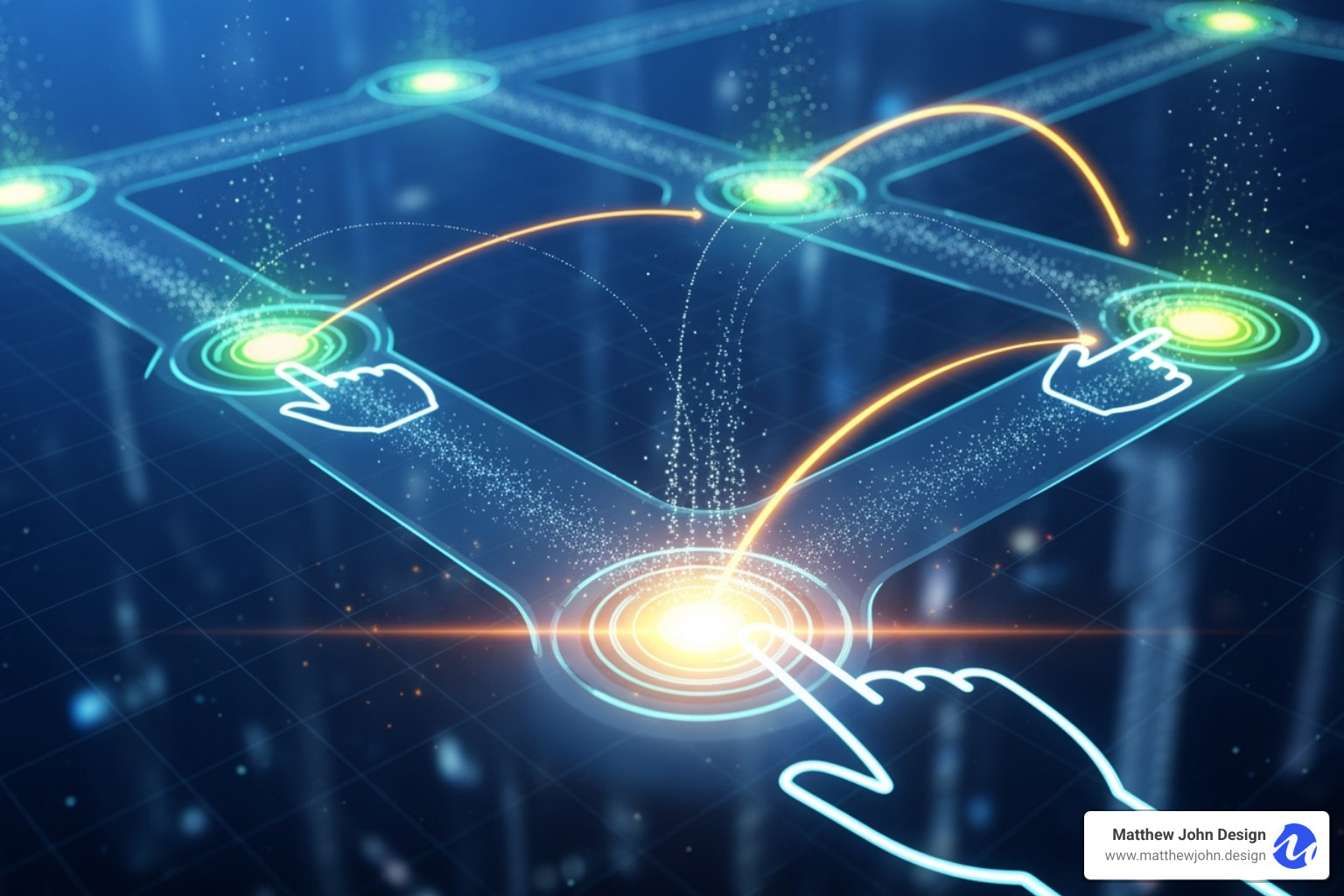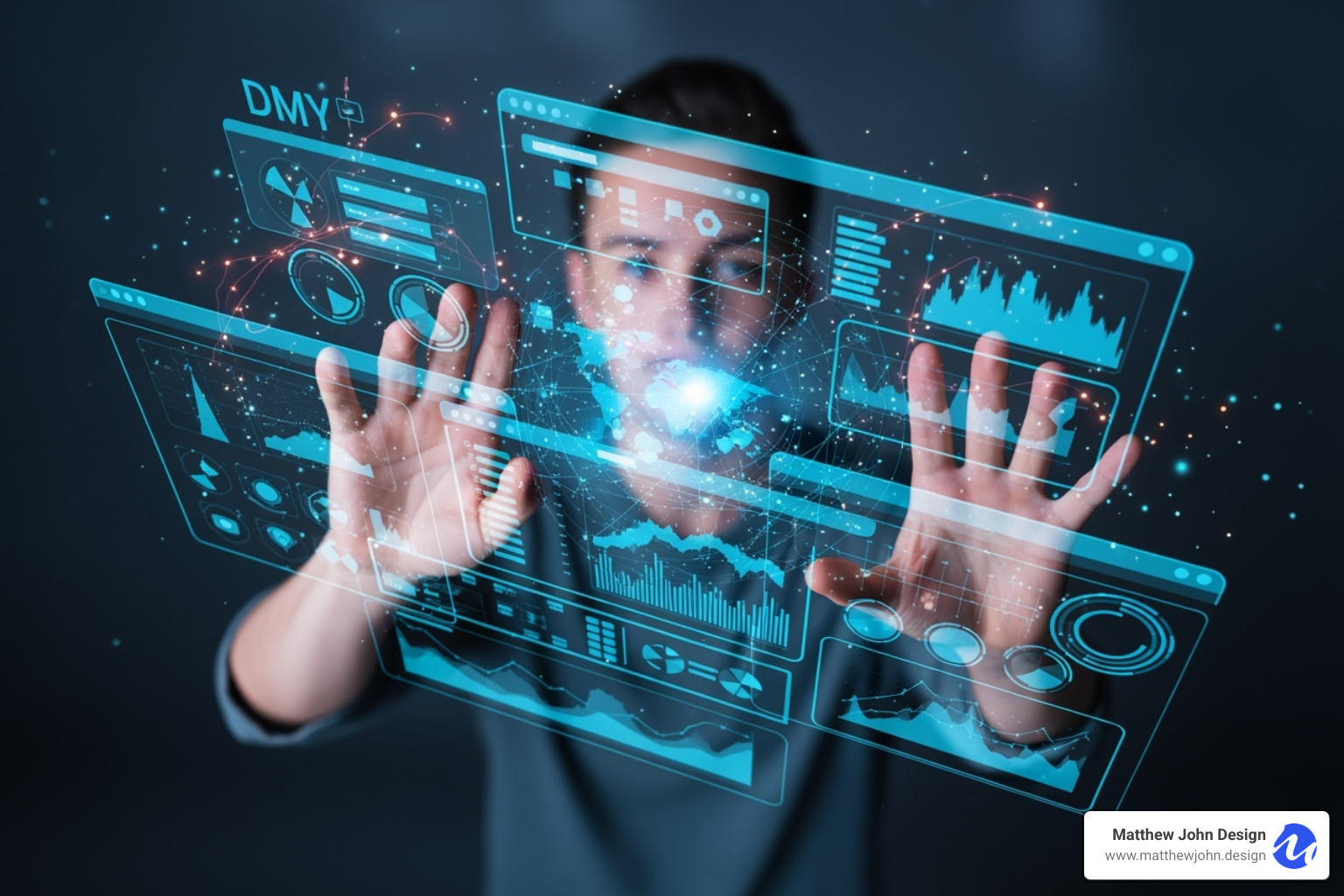Any information contained on this Website is not legal advice and should not be treated as such. You should always contact an attorney for help with your specific legal needs and issues. We may also earn a commission when you click links to our partners and purchase goods or services. For more information, read our Disclaimers Policy.
Beyond Static Pages: The Evolution of Web Experience
Creative interactive web design transforms passive browsing into active engagement through dynamic elements that respond to user actions. Instead of reading static content, visitors click, scroll, hover, and play their way through immersive digital experiences.
Key Elements of Creative Interactive Web Design:
- Hover animations that reveal hidden content or transform elements
- Scroll-triggered effects that unfold stories as users steer
- Micro-interactions that provide instant feedback on user actions
- Gamified experiences like quizzes, calculators, and configurators
- Dynamic content that adapts based on user behavior
- 3D elements and immersive environments
- Interactive storytelling that puts users in control of the narrative
The shift from static to interactive isn't just about looking cool. Research shows that 88% of users won't return to a website after a bad experience, while 59% of users want something beautifully designed when they have limited time to consume content.
Interactive design directly impacts your bottom line. Sites with engaging elements see users spending 88% more time on pages with videos, while 73% of marketers report that combining interactive elements with traditional content boosts retention rates and engagement.
But here's the catch: 53% of users will leave your site if it doesn't load in 3 seconds or less. This means your interactive elements must improve the experience without sacrificing performance.
The most successful interactive websites balance creativity with usability, ensuring every animation and effect serves a purpose in guiding users toward their goals.

Why Bother with Interactive Design? The Impact on Your Audience and Goals
When users land on your site, they should be interacting, not just reading. That's the power of creative interactive web design. With 59% of users wanting something beautifully designed in their limited time, interactive elements are more than just cool effects—they're strategic tools for engagement and conversion. By turning passive readers into active participants, you create memorable experiences that boost brand recall and drive business goals. At Matthew John Design, our Website Design and Development Services focus on balancing creativity with performance, using component-based systems that are easy for your team to manage.
The Psychology of Interaction: Grabbing and Holding Attention
The psychology behind interactive design is simple: immediate feedback creates engagement. When a button changes color on hover or an animation unfolds on scroll, it gives users a sense of control, keeping them on the page.
Micro-interactions are key. These tiny, responsive animations make your site feel alive, guiding users and changing a simple browsing session into a delightful experience. But the stakes are high: 88% of users won't return after a bad user experience, so every interaction must be purposeful. These elements create emotional connections, making your brand more memorable and effective than a static digital brochure.
The Business Case: Driving Conversions and Reducing Bounce Rates
With the average eCommerce bounce rate at 48.4%, nearly half of potential customers leave without engaging. Creative interactive web design combats this by inviting exploration from the start.
Interactive elements like smart lead generation forms, product configurators, and scroll-triggered animations guide users through the sales funnel more effectively. They turn passive visitors into active participants, boosting key performance indicators. Increased time on page and lower bounce rates improve SEO, and more importantly, engaged users are more likely to convert. Our approach to Optimizing Webflow Sites for Conversions (CRO) leverages these elements to guide users toward desired actions.
The Performance Pact: Interactivity vs. Speed
The challenge with interactivity is performance. With 53% of users leaving a site that takes more than 3 seconds to load, speed is non-negotiable. This is the "performance pact": balancing engaging design with fast load times.
Asset compression is crucial. Every interactive element must be optimized for speed. This involves smart coding, efficient loading, and a focus on Core Web Vitals, especially for mobile users. The goal is to build experiences that improve, not hinder, performance. Modern web technologies make it possible to create complex, fast-loading animations that keep users engaged.
The Core Components of Creative Interactive Web Design

Building an engaging website requires thoughtfully layering interactive components into a cohesive experience. At Matthew John Design, we use platforms like Webflow to create scalable, component-based systems that are stunning yet manageable for your marketing team. See our principles in action in our Web Design Portfolio.
Foundational Interactive Elements
These core elements are the building blocks of a dynamic digital experience.
Hover animations are your first line of engagement. When a button subtly changes color or an image zooms on hover, you create a crucial moment of connection.
Micro-interactions are tiny, single-purpose animations, like a form field turning green after valid input. These details make a site feel professional and responsive.
Dynamic scrolling transforms moving down a page into a journey, with elements appearing and changing to create a sense of progression.
Parallax effects add depth by moving background elements at different speeds than the foreground, creating an almost cinematic quality.
Animated cursors can add a unique branded touch, like a cursor that changes shape over clickable elements, making your site memorable.
Page transitions eliminate jarring page loads, creating a seamless, app-like experience that keeps users engaged.
Form validation feedback is crucial for user experience, providing real-time feedback that reduces frustration and improves completion rates.
Advanced Interactivity: Gamification and Storytelling
Advanced elements create emotional connections and memorable experiences.
Gamification taps into our love of achievement with elements like progress bars or quizzes. BuzzFeed uses quizzes to engage its audience, turning casual visitors into highly engaged users.
User-driven narratives put visitors in control, letting them make choices that shape their experience, such as a choose-your-own-trip journey through your product offerings.
Calculators and product configurators provide immediate value while generating qualified leads. A user who customizes a product is already mentally invested in your solution.
Building excellent Webflow websites means every interaction is strategic, guiding users toward your business goals while creating an enjoyable experience.
Leveraging Video and 3D Graphics
Video and 3D elements are powerful tools for engagement. Statistics show users spend about 88% more time on websites that have videos, but they must be used strategically.
Background videos can set the mood in hero sections but require careful optimization. Product demos using interactive 3D models let users explore items from every angle, which is powerful for e-commerce. 3D models and WebGL open up possibilities for fully immersive experiences that make your brand stand out.
It's crucial to know that Webflow only supports background videos up to 30 MB and lacks native hosting for larger files. For longer or higher-quality videos, we recommend third-party hosting solutions like YouTube, Vimeo, or Vidzflow to ensure optimal performance.
Building User-Friendly Drag-and-Drop Interfaces
One of the most powerful aspects of modern web development is creating an easy-to-use drag-and-drop system with Webflow components and page building for frontend interactions. This isn't about Webflow's backend editor—it's about empowering your website visitors with intuitive, interactive experiences.
Imagine a product builder where users can drag and drop features to customize an item. We achieve this by building custom frontend drag-and-drop interactions, often integrating lightweight JavaScript libraries like Shopify's Draggable library to make these interactions smooth and accessible.
These systems engage users by giving them control, provide valuable data on their preferences, and can significantly increase conversion rates. We always build this functionality with accessibility in mind, providing alternative navigation methods to ensure your interactive elements are inclusive. The key is making these interactions feel natural and intuitive, creating a level of engagement that static websites simply can't match.
Inspiring Examples of Interactive Websites

Sometimes the best way to understand creative interactive web design is to see it in action. There's something magical about finding a website that makes you stop scrolling and actually start playing. These aren't just pretty sites – they're digital experiences that stick with you long after you've closed the browser tab.
The websites that win Awwwards and inspire designers worldwide share something in common: they understand that great UI/UX design isn't just about looking good. It's about creating a connection. Let's explore some standout examples that show how creativity and smart frontend development can transform ordinary websites into extraordinary experiences.
Example 1: Bruno Simon's Gamified Portfolio
Bruno Simon didn't just build a portfolio – he built a playground. Instead of the usual "scroll down to see my work" approach, he created an entire 3D environment where you drive a tiny red truck around using your keyboard. It's completely unexpected and absolutely delightful.
This gamified experience turns job hunting into an trip. You're not just reading about his skills; you're experiencing them firsthand. The playful UX makes you want to explore every corner of his digital world, collecting projects like treasures. It's the kind of site that makes you smile while showcasing serious technical chops.
We love this approach because it shows how personal branding can be both fun and professional. Just like our Willo AI Intelligence Landing Page Design, it proves that standing out doesn't mean sacrificing substance.
Explore Bruno's playable portfolio
Example 2: Cyclemon's Parallax Storytelling
Cyclemon proves that sometimes the simplest ideas work best. This site takes you on a visual journey through different bicycle styles using parallax scrolling that feels effortless and natural. As you scroll, beautifully crafted illustrations unfold at different speeds, creating depth and movement that draws you deeper into the story.
What makes this site special isn't flashy effects – it's the thoughtful way each scroll-triggered animation reveals new content. The illustrations have personality, and the parallax effect makes you feel like you're actually moving through different cycling worlds. It's a masterclass in using visual narrative to keep users engaged without overwhelming them.
Example 3: BrandStudio's Immersive Scroll Experience
BrandStudio's website shows how neat restraint can be more powerful than flashy effects. Their scroll-based storytelling uses dynamic animations and seamless transitions that feel sophisticated rather than showy. The minimalist UI lets the content breathe while perfectly timed reveals create a sense of findy.
Every scroll feels intentional. The seamless transitions guide you through their brand story with subtle animations that improve rather than distract from the message. It's the kind of polished experience that makes you trust the brand before you've even read all the content.
Experience BrandStudio's narrative
Example 4: The (UN)TRAFFICKED Choose-Your-Own-Trip
This powerful project uses interactive narrative to tackle a serious social issue. The (UN)TRAFFICKED experience puts you in control of choices that reveal the harsh realities of human trafficking. It's not entertainment – it's education through emotional engagement.
The choose-your-own-trip format makes you an active participant rather than a passive reader. Each choice leads to different outcomes, showing how complex and dangerous these situations can be. It's a brilliant example of how user choice can create deeper understanding and lasting impact.
This site reminds us that interactivity isn't just about business goals – it's about human connection. When we build Webflow Interactive Websites, we're always thinking about how to create meaningful experiences that resonate with real people.
Make a choice in the (UN)TRAFFICKED story
Future-Proofing Your Site with Creative Interactive Web Design Trends

The web moves fast, and what looks cutting-edge today might feel outdated tomorrow. That's why creative interactive web design isn't just about what works now – it's about building sites that can evolve with changing user expectations and emerging technologies. We're constantly exploring new possibilities and sharing insights through our Web Design Blog Articles to help you stay ahead of the curve.
Think of it this way: your website is an investment, not just an expense. Future-proofing means making smart choices today that will keep your site relevant and engaging for years to come. The trends we're seeing point toward more immersive, personalized, and intelligent web experiences that blur the lines between digital and physical worlds.
Artificial Intelligence and Generative Visuals
Artificial intelligence is revolutionizing how we create and think about visual content. Tools like Midjourney and DALL-E are making it possible to generate unique, brand-specific illustrations on demand. This isn't just about saving time – it's about creating truly original visual experiences that would be impossible or prohibitively expensive to produce traditionally.
Imagine a website where the background imagery dynamically adapts based on user preferences, or where product illustrations are instantly generated to match specific configurations. This level of customization creates a more efficient design process while ensuring your brand visuals remain completely unique. We're already seeing examples of this in action with sites like Flowpark, which showcases how AI-powered design can create stunning, personalized experiences.
The beauty of AI-generated visuals lies in their ability to maintain brand consistency while offering infinite variety. Instead of relying on stock photos that your competitors might also use, you can create a visual language that's entirely your own.
The Rise of 3D and Immersive Environments
We've touched on 3D graphics earlier, but their role is expanding rapidly. We're moving beyond simple 3D product showcases toward fully immersive WebGL experiences that feel more like virtual worlds than traditional websites. This trend promises to make online interactions more tactile and engaging than ever before.
Companies like Apple are already leading the way with sophisticated 3D models for their products, allowing users to interact with devices in highly realistic ways. But this technology isn't just for tech giants. Small businesses can now create virtual showrooms, interactive educational environments, and even early metaverse integrations that give users a sense of presence and exploration.
The key is implementing these technologies thoughtfully. A 3D element should improve the user experience, not overwhelm it. When done right, improved realism in web design can dramatically increase engagement and help users make more confident purchasing decisions.
Hyper-Personalization and Dynamic Content
The future of interactive web design is deeply personal. By leveraging user data and advanced API integrations, websites are becoming incredibly adept at delivering personalized journeys that adapt in real-time. This goes far beyond just showing someone's name in a welcome message.
Picture a landing page that reconfigures its layout and offers based on whether a visitor is new or returning. Or a news site that highlights articles most relevant to your interests and browsing history. Dynamic content blocks can now shift, rearrange, and customize themselves based on dozens of factors, from location and device type to past behavior and stated preferences.
This level of improved user relevance significantly boosts engagement and conversion rates by making every interaction feel uniquely custom. Users no longer feel like they're browsing a generic website – they feel like they're exploring a digital space designed specifically for them.
The technology behind this personalization is becoming more accessible, meaning even smaller businesses can create these sophisticated, adaptive experiences that were once the exclusive domain of major corporations.
Frequently Asked Questions about Creative Interactive Web Design
We get a lot of questions about creative interactive web design from business owners who want to understand what it means for their websites. Let's explore the most common concerns and clear up any confusion.
What is creative interactive web design?
Creative interactive web design goes beyond static pages to create a true two-way conversation between your website and its visitors. Instead of just reading content, users can click, hover, scroll, and interact with elements that respond to their actions. This creates an engaging experience that feels alive and responsive.
Think of it as the difference between reading a book and playing a game. With interactive design, users become active participants rather than passive observers. They might scroll through animated storytelling sections, hover over buttons that transform, complete quizzes that reveal personalized results, or manipulate 3D product models.
Common examples include scroll-triggered animations that unfold as you move down the page, hover effects that reveal hidden information, interactive forms that provide real-time feedback, and gamified experiences like calculators or configurators. The goal is always to improve user engagement and create memorable experiences that guide visitors toward your business objectives.
Do interactive elements hurt SEO?
This is probably our most frequent question, and I totally get why people worry about this. The short answer is: not when done right, and they often help your SEO significantly.
Here's the thing - search engines like Google have gotten really good at understanding JavaScript and interactive content. The days of search engines struggling with dynamic websites are largely behind us. Modern crawlers can render and index interactive elements just fine.
The real SEO impact comes down to user experience signals. When interactive elements create a better experience, they lead to lower bounce rates, increased time on page, and higher engagement - all factors that search engines love. 88% of users won't return to a website after a bad experience, so engaging interactive elements actually protect your SEO by keeping visitors happy.
The potential pitfall is performance. If your interactive elements slow down your site significantly, that's when you might see negative SEO impacts. But when we build creative interactive web design with proper optimization, asset compression, and efficient coding, the performance stays solid while the engagement soars.
How much does an interactive website cost?
I wish I could give you a simple number, but interactive website costs vary as much as the complexity of the features you want. It's like asking "how much does a house cost?" - the answer depends on what you're building.
Several factors influence the investment:
Complexity and scope make the biggest difference. Simple hover animations and scroll effects are relatively straightforward to implement. But if you want a full 3D product configurator or a gamified experience with multiple user paths, that requires significantly more development time and expertise.
Custom animations versus templates also affects cost. We can implement pre-built interactive components more quickly, but truly unique, branded interactions require custom development work.
Development time scales with complexity. More sophisticated interactions need more hours from designers, developers, and quality assurance testing to ensure everything works smoothly across different devices and browsers.
The good news is that we specialize in building Webflow sites with scalable component-based systems that your internal marketing team can manage. This approach reduces long-term costs because you won't need ongoing developer support for content updates and basic changes.
Most importantly, consider the return on investment. Interactive elements typically boost engagement, reduce bounce rates, and increase conversion rates. When your website works harder to convert visitors into customers, the investment often pays for itself through improved business results.
Conclusion: Start Building a More Engaging Web
We've taken quite a journey through the exciting world of creative interactive web design, exploring everything from foundational hover effects to cutting-edge AI-generated visuals. The message is crystal clear: the days of static websites are numbered. If you want to truly capture attention, keep visitors engaged, and drive real business results, your website needs to be dynamic, responsive, and genuinely delightful.
But here's the thing – creativity without performance is just pretty frustration. A stunning interactive site that takes forever to load is like having a Ferrari with flat tires. It looks amazing, but it won't get you where you need to go. That's why our approach at Matthew John Design focuses on building robust, lightning-fast Webflow sites with scalable component-based systems that look incredible and function flawlessly.
The beauty of our user-centric approach is that it doesn't just benefit your visitors – it empowers your internal marketing teams too. When we build these interactive experiences, we're thinking about the person who'll need to update content next month, add new products next quarter, or launch that holiday campaign. Our scalable systems mean you can evolve your digital presence without needing a computer science degree.
The future of the web is interactive, immersive, and personalized. We're moving toward a world where websites adapt to each visitor, where AI creates unique visuals on the fly, and where 3D environments make online shopping feel as real as walking into a store. Don't let your website get stuck in the static past while your competitors create experiences that truly connect with audiences.
The web has evolved from a digital brochure to a dynamic conversation. Your website should be part of that conversation, not a monologue. Every scroll, click, and hover should feel intentional and rewarding. That's what separates memorable brands from forgettable ones.
Ready to transform your digital presence into an engaging experience that actually works? Start your next project with our Website Design and Development services, and let's build something truly remarkable together.

